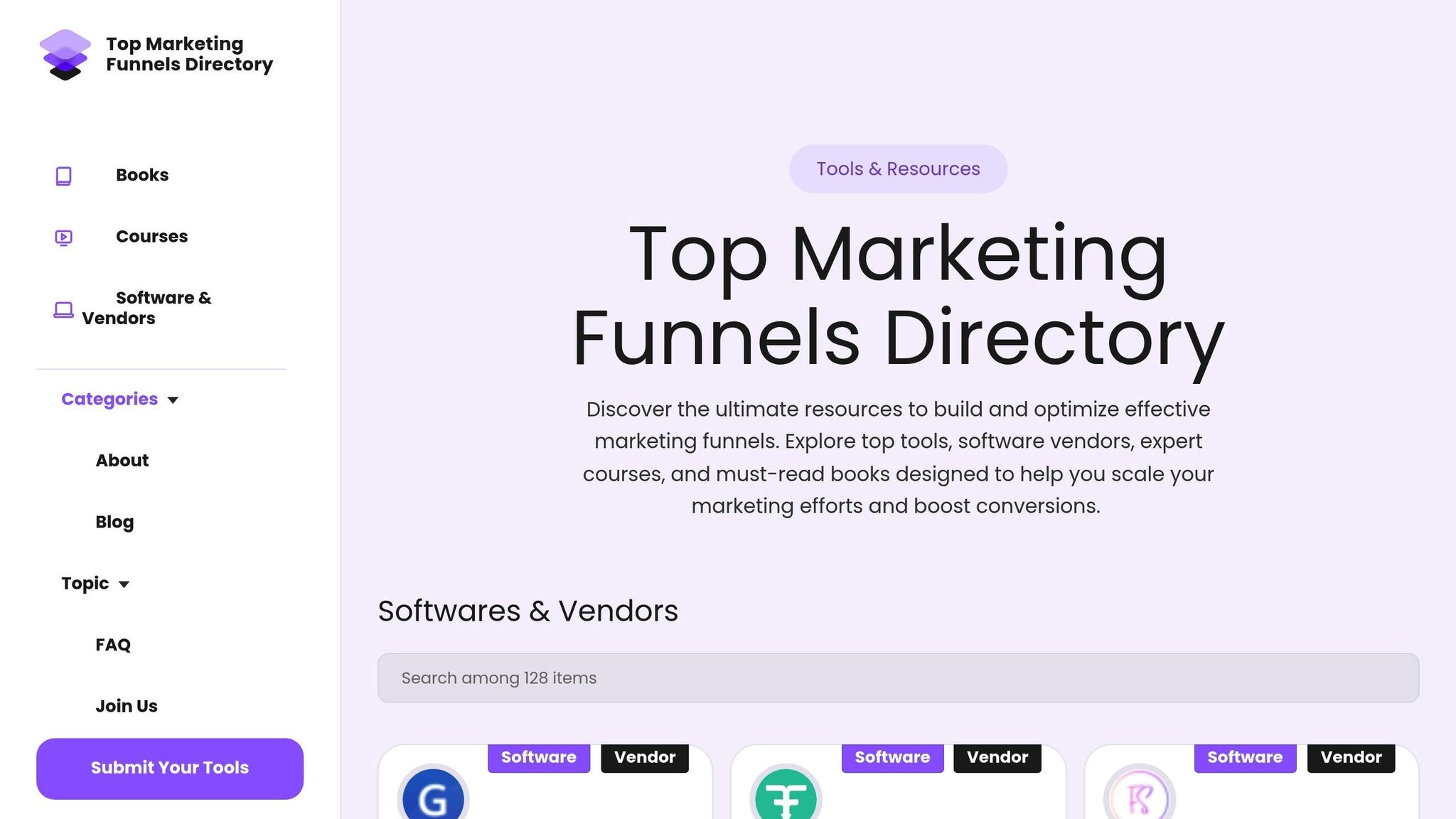Every time someone starts filling out your form but doesn’t finish, it’s a missed opportunity - and likely lost revenue. On average, 68% of users abandon forms, often due to issues like confusing fields, poor mobile design, or asking for too much information upfront. The good news? You can pinpoint exactly where users drop off and why using tools like Google Analytics, Hotjar, or Zuko.
Here’s what you need to know:
- Key Metrics to Track: Monitor abandonment rates, time spent per field, and error rates to identify problem areas.
- Common Reasons for Drop-Offs: Overly long forms, unclear labels, lack of trust signals, or technical glitches.
- Fixing Drop-Offs: Simplify forms, use clear instructions, and test changes with A/B testing to see what works.
Why Users Abandon Forms at Specific Fields
What Are Form Field Drop-Offs
Form field drop-offs happen when users start filling out your form but stop before hitting "submit." They might fill in a few fields, hit a snag, and then decide to leave altogether. This is different from visitors who never touch your form - these users were already engaged but hit a roadblock that made them quit.
Think of it like someone standing in line at a store, ready to check out, but walking away when they see a long wait or an unexpected fee. Similarly, users invest their time and effort into your form, but if something feels too difficult or unclear, they may decide it’s not worth the hassle.
Form abandonment isn’t the same as a bounce rate. While bounce rates measure users who leave without interacting, drop-offs occur after users have already started engaging with your content. That makes them even more frustrating because you were so close to securing a lead or a sale.
Common Reasons Users Leave Forms
One major reason people abandon forms is when they're asked for too much information upfront. Long forms can feel overwhelming, especially on mobile devices where patience is already limited.
Poor mobile design can also drive users away. A form that works well on a desktop might be a nightmare on a smartphone. Tiny input fields, hard-to-tap buttons, or text that's too small can quickly frustrate users. Since mobile traffic accounts for a big chunk of web usage, these issues can seriously hurt your conversion rates.
Confusing field labels are another common culprit. If a label isn’t clear - say, something vague like "Code" or "Reference" - users might give up rather than guess what’s being asked.
Lack of trust signals can make users hesitant to provide personal information. Without visible security badges, privacy statements, or clear explanations about how their data will be used, users may worry about spam or potential breaches.
Technical glitches - like slow-loading forms, unclear error messages, or browser compatibility issues - can abruptly end a user’s progress. These moments of frustration often lead to abandonment.
Irrelevant or poorly timed questions also discourage users. For example, asking for sensitive details like income or a phone number too early in the process, or including fields that feel unnecessary, can make users question whether it’s worth continuing.
By understanding these pain points, you can start to see how they chip away at your form’s effectiveness.
How Drop-Offs Hurt Your Marketing Funnels
When users abandon forms, it’s more than just a design issue - it’s a blow to your entire conversion process. Every incomplete form represents a missed opportunity, and over time, these small losses can add up to a significant revenue shortfall.
Abandoned forms also waste the effort and money you’ve spent driving traffic to your site. Whether your visitors came through paid ads, SEO, or content marketing, each drop-off means part of your investment isn’t delivering results.
High drop-off rates can also hurt your sales team by reducing the number of qualified leads they receive. On top of that, it can skew your campaign performance data, making it harder to refine your marketing strategy effectively.
The ripple effect is costly. To make up for the lost conversions, you’ll need to drive even more traffic, which increases your customer acquisition costs and makes your marketing efforts less efficient overall.
For businesses using Marketing Funnels Directory tools and resources, this makes form optimization crucial. These tools and strategies are most effective when your forms successfully turn interested visitors into leads or customers - so minimizing drop-offs should be a top priority.
Metrics and Tools for Tracking Drop-Offs
Key Metrics to Track
Understanding where users drop off in your forms can help you make targeted improvements. Here are the most important metrics to monitor:
- Form abandonment rate: This tells you the percentage of users who start filling out your form but don’t finish. To calculate, divide the number of incomplete submissions by the total form starts, then multiply by 100. A high abandonment rate signals issues with your form’s design or process that need immediate attention.
- Field-level drop-off rates: This metric pinpoints the exact fields where users give up. If one field sees a significantly higher drop-off than others, it’s a clear sign that it needs adjustments.
- Time spent per field: Measuring how long users spend on each field can reveal problem areas. If users hesitate too long on a particular section, they may be confused by unclear instructions or poorly designed fields.
- Completion time: Tracking how long it takes users to complete your form can help identify friction points. Longer times, especially on mobile devices, often correlate with higher abandonment rates.
- Error rate by field: High error rates in certain fields can highlight confusion caused by unclear instructions, poor validation messages, or complicated formats. These areas are prime candidates for refinement.
- Mobile vs. desktop performance: Comparing abandonment rates between mobile and desktop users can uncover device-specific challenges. Mobile users often face unique usability issues, so this metric helps prioritize mobile-friendly improvements.
Analytics Tools for Form Tracking
To effectively monitor and analyze form performance, several tools can provide valuable insights:
- Google Analytics 4: This platform lets you track form interactions using custom events and enhanced measurement features. You can monitor when users start a form, complete specific fields, or abandon the process. Funnel visualization reports make it easier to identify drop-off points.
- Hotjar: With heatmaps and session recordings, Hotjar automatically tracks form interactions. It provides data on completion rates, time spent on each field, and where users drop off.
- Mouseflow: This tool records user behavior, capturing mouse movements, clicks, and scrolling patterns. Its dashboard highlights troublesome fields and user hesitation, making it easier to identify problem areas.
- Zuko: Designed specifically for form optimization, Zuko offers detailed field-by-field analysis. It tracks completion rates, error occurrences, and time spent on each field. Plus, its A/B testing capabilities help you refine designs further.
- Crazy Egg: Combining heatmaps with form tracking, Crazy Egg shows which elements attract clicks and how far users scroll through your form. This helps you see if critical sections, like the submission button, are being missed.
These tools are typically integrated using JavaScript snippets, and many offer free plans to get started. By using them alongside session replays and heatmaps, you can gain a complete view of user behavior.
Using Session Replays and Heatmaps
To dive deeper into user behavior, session replays and heatmaps are invaluable tools:
- Session replays: These recordings capture every click, scroll, and navigation movement users make. They can reveal patterns, such as repeated clicks on non-interactive elements, that indicate usability issues.
-
Heatmaps: These visual tools use color coding to show engagement levels across your form:
- Click heatmaps: Highlight where users click most often, helping identify if they mistakenly interact with non-clickable elements.
- Scroll heatmaps: Show how far users scroll, helping you determine if important sections, like the submit button, are being overlooked.
By combining session replay data with metrics like abandonment rates and field-level drop-offs, you can build a complete picture of how users interact with your forms. This approach allows you to identify pain points and make informed decisions to optimize your forms.
For additional resources and tools to enhance your form optimization efforts, the Marketing Funnels Directory offers a variety of solutions tailored to improving conversion rates and addressing drop-off challenges.
How to Analyze Form Field Drop-Offs Step by Step
Setting Up Form Tracking
Start by adding the necessary analytics scripts to your website's header. For Google Analytics 4, include the gtag.js snippet on every page with a form. This enables automatic tracking of form interactions using enhanced measurement features.
If you're using form builders like Gravity Forms in WordPress, look for options like "Enable Analytics" under advanced settings. For custom HTML forms, you’ll need to manually add event tracking code using JavaScript.
For tools like Hotjar or Mouseflow, insert their tracking scripts into your site’s header. These tools typically start collecting interaction data shortly after setup. Just make sure to adjust privacy settings to comply with GDPR and other data protection regulations.
If you're working on an e-commerce platform, many tracking apps integrate directly with checkout and contact forms, simplifying the setup process.
Reading Your Analytics Data
Once tracking is live, dive into the data to uncover actionable insights. Most analytics tools have a dashboard where you can access form reports. Navigate to the "Insights" or "Forms" section, select the specific form you’re analyzing, and open the "Detailed Report" tab. This report typically includes two critical sections: Conversion Funnel Report and Field Statistics.
The Field Statistics section is especially useful for identifying drop-off points. Pay close attention to the "DROPPED" percentage for each field. A drop-off rate above 10% for required fields could indicate a problem.
Other key metrics to monitor:
- Hesitation Time: If users pause for more than 8 seconds on a simple field, it may signal confusion.
- Refilled Percentage: A high rate (above 25%) suggests users are struggling with unclear labels or validation issues.
- Ignored Percentage: If over 15% of required fields are left blank, it points to poor field design.
| Metric | What It Reveals | Red Flag Threshold |
|---|---|---|
| DROPPED | Where users abandon the form | Above 10% for required fields |
| HESITATION TIME | Average pause before interacting | Over 8 seconds for simple fields |
| REFILLED | Frequency of users changing their input | Above 25% |
| IGNORED | Required fields left blank | Over 15% |
Use date filters to compare performance over different time periods. For example, check if recent website updates have improved or worsened form completion rates by comparing data from the past week to the previous month.
Combining Numbers with User Behavior Data
Numbers alone tell part of the story. To get the full picture, pair your analytics with user behavior data from tools like session replays and heatmaps. While the numbers show what is happening, behavior data helps explain why users are dropping off.
Filter session recordings to focus on users who abandoned the form and review their interactions. Look for patterns like repeated clicks on non-interactive elements, excessive scrolling, or extended hovering over help text. These behaviors often point to usability issues.
For example, if analytics show a high drop-off rate at the phone number field, and heatmaps reveal heavy activity near the instructions, users might be confused about the required format. Similarly, hesitation time data paired with scroll heatmaps can highlight areas where users are searching for clarification or context.
Session replays can also uncover validation or formatting challenges. If users repeatedly type and delete content in a specific field, it’s a clear sign that something isn’t working as expected.
Document the fields with the highest drop-off rates and note any related user behaviors. Combining these insights allows you to make targeted changes to your form design, ultimately improving completion rates.
How to Measure and Decrease Form Abandonment
sbb-itb-a84ebc4
How to Fix Forms and Reduce Drop-Offs
To tackle form abandonment effectively, you need a strategy grounded in data. By using drop-off analytics as your compass, you can make targeted adjustments that encourage users to complete your forms. Here’s how to approach it:
Test and Monitor Your Changes
- Run A/B tests on key updates: Compare your current form (the control) with a modified version. Split your traffic evenly between the two and track completion rates over a two-week period to see which performs better.
- Analyze user behavior: Keep an eye on metrics like completion rates, time spent on the form, and where users drop off. Tools like session replays and heatmaps can give you a deeper look into how users interact with your form.
- Set up performance alerts: Use your analytics platform to create automated notifications. For example, get alerted if completion rates fall below a certain level. In the early stages, review analytics weekly, then transition to monthly checks as you gather more data.
- Adjust and refine over time: Use the insights from your monitoring to make iterative improvements to the form. Small, data-driven tweaks can lead to big results.
- Document what works: Keep a record of successful changes. These can serve as a playbook for future optimizations, helping you build on past successes.
Adding Drop-Off Analysis to Your Marketing Strategy
Form drop-off analysis can be a game-changer for your marketing efforts. By identifying exactly where users abandon your forms, you uncover friction points that might otherwise go unnoticed. This insight doesn’t just help you fix one form - it provides a roadmap for improving the entire customer journey. Essentially, it’s a strategy that goes beyond quick fixes and focuses on creating a smoother, more effective path for users.
How Drop-Off Analysis Improves Conversion Rates
Drop-off analysis shines a light on the weak spots in your conversion funnel. When you know where users are losing interest or getting stuck, you can take targeted action to address those issues. This process helps you eliminate bottlenecks, make adjustments, and track the impact of those changes - all of which can lead to higher conversion rates.
For example, if you notice a sharp drop-off at a specific form field, it could signal a problem with trust, clarity, or even relevance. Armed with this knowledge, you can make informed changes that resonate with users and improve their experience. This approach ensures your decisions are based on real data rather than guesswork, ultimately boosting conversions.
Interestingly, while 58% of companies rely on A/B testing to improve conversions, drop-off analysis offers a layer of insight that A/B testing alone might miss. It uncovers subtle user experience issues, allowing you to create marketing strategies that address genuine concerns instead of working off assumptions.
Using Marketing Funnels Directory Resources

The insights you gain from drop-off analysis can also guide your choice of optimization tools. That’s where the Marketing Funnels Directory comes in. This resource is packed with tools, vendors, courses, and books designed to help you fine-tune your forms and improve your overall funnel performance. Whether you’re tackling form abandonment or refining your broader marketing strategy, the directory has you covered.
What makes this directory so helpful is its range. It includes everything from social media and advertising tools to B2B-specific solutions and content creation resources. For example, you’ll find tools for form analytics alongside complementary solutions like landing page builders, email automation platforms, and user behavior tracking software - all in one place.
When putting drop-off analysis into action, you’ll often need a combination of tools. Maybe you’ll use a form analytics tool to pinpoint drop-off points, a heatmap tool to visualize user behavior, and an A/B testing platform to confirm your updates are working. The Marketing Funnels Directory helps you find tools that integrate seamlessly, making your optimization process more efficient.
On top of that, the directory offers educational resources like courses on mastering sales funnels and books on advanced marketing strategies. These materials help you see the bigger picture, connecting form performance data to other key funnel metrics. This way, you can build a well-rounded view of your customer journey and make smarter, more impactful decisions.
Conclusion
Understanding where users drop off in your forms is key to tackling the friction points that hurt your conversion rates. It all begins with accurate tracking to pinpoint exactly where users abandon the process. Once you have the data, you can dig deeper to uncover why they’re leaving and make targeted adjustments. Testing those changes ensures they deliver real results.
But here’s the thing - this isn’t a one-and-done process. User behavior evolves, and what works today might fall flat in the future. Regular monitoring is essential to staying ahead of new challenges. With form abandonment rates hovering between 60% and 80% across industries, there’s always room to improve.
Focus your analytics on the metrics that matter most: how many users view your form, how many start filling it out, where they drop off, and how many actually complete it. These numbers give you a roadmap to understand user struggles. Pairing this with session recordings and heatmaps provides a fuller picture of their experience, helping you turn insights into actionable improvements.
Even small tweaks can make a big difference. Clear labels, inline validation, and mobile-friendly designs are just a few examples of changes that can significantly improve the user experience and reduce friction.
To keep optimizing, consider leveraging resources like the Marketing Funnels Directory. It’s packed with tools, courses, and platforms to help with everything from advanced analytics to A/B testing. Having the right tools in your corner can simplify the process and make your efforts more effective.
FAQs
How can I improve mobile form design to reduce user drop-offs?
To keep users engaged and reduce drop-offs on mobile forms, start by prioritizing responsive design. A design that adjusts seamlessly to smaller screens ensures better usability. Use larger fonts for readability and buttons that are easy to tap, making interactions smooth and frustration-free.
Another key tip: simplify the layout. A single-column format works wonders for readability and keeps the experience straightforward. For longer forms, break them into shorter, logical steps. This approach eases cognitive load and makes the process feel less overwhelming.
Finally, cut down on the number of required fields and take advantage of autofill options whenever possible. These small tweaks streamline the experience, making it more likely that users will complete the form on their mobile devices.
How can I use session replays and heatmaps to understand why users abandon my forms?
To figure out why users are leaving your forms unfinished, tools like heatmaps and session replays can be game-changers. Heatmaps give you a clear, visual snapshot of user activity - showing where people click, scroll, or just stop engaging. This makes it easier to spot areas in your forms that might be confusing or frustrating.
On the other hand, session replays let you watch individual user sessions in action. You can see exactly how someone interacts with your form, whether they hesitate on certain fields or leave abruptly. When you use these tools together, patterns start to emerge. You’ll be able to pinpoint problem areas, address user frustrations, and fine-tune your forms to encourage more people to complete them.
What are the best practices for tracking and analyzing form drop-offs using tools like Google Analytics or Hotjar?
To get a clear picture of where users abandon your forms, start by using funnel analysis in tools like Google Analytics. This will help you identify the exact step where drop-offs occur. Pair this with tools like Hotjar to review session recordings and heatmaps, giving you a closer look at how users interact with specific form fields and where they might encounter challenges.
Dig deeper by analyzing multiple metrics, such as page visits, interactions with individual form fields, and overall drop-off rates. Use these insights to pinpoint problem areas. From there, make regular tweaks to your form design to smooth out the user experience and encourage more completions.


